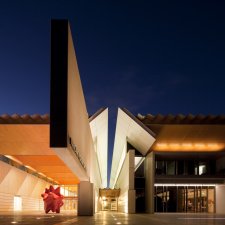- The most important things that can happen to you, standing in front of whichever painting it might be, can only happen with a painting. It's the experience of whatever the hell a painting is, and the most important and profound and life-changing things that can happen to you when you look at a photograph can only happen with a photograph. It's a photograph. They're totally different things.
- [Interviewer] Usually I start with, at the very beginning, and talk about your childhood, but we might work our way back to that. And, if we could maybe start with the story of the Simone Young commission.
- I went to watch Simone in rehearsals at Hamer Hall in Melbourne a couple of times, and I had the same problem I had when I was doing the commission for the Paris Opera, which was that I didn't want to make pictures which were just a document of something else. I wanted to make pictures which were a thing in their own right, if you know what I mean. And so, by photographing her in the pit, with an orchestra, rehearsing, whatever it was at the time, I just thought, it's just never going to look as interesting as in its own right, as, so the picture becomes the subject, rather than the event that's being documented being the subject, which is one of those great conundrums for photography.
- And so, I organised for Simone to visit me in my studio in Northcote, and we'd met and discussed things briefly, at rehearsals, but she came along, and she said, "I've brought my shoes." I said, "It's from the waist up." She said, "I need my shoes." So she put the shoes on, and I'd constructed this couple of crates in my studio that I wanted her to stand on. And then I, we had a conversation. I said, "Well, you know, what have you, "what are you working on at the moment?" And she was preparing to conduct "Der Rosenkavalier," the Richard Strauss. And I said, "Oh, well, you know, why don't we put it on, "and why don't you, you know, conduct to the music?" I said, "You know, it's strange, of course." And she said, "It's very strange, because I lead. "Whereas if I'm listening to a recording and try to conduct, "I'm following the recording." And I said, "Well, it might be interesting for you. "Let's give it a go." And she said, "Well, you know, the only recording that I really have been listening to carefully is by Erich Kleiber, and you're not going to have that." And I go, "Well, here it is." So I pulled out the Erich Kleiber recording, Carlos Keliber's father. Great conductor, and we put that on, and she started, she got into it, and she started conducting, and I was just taking pictures, and everything else, and we kept going, and we kept going, and we both got quite a good sweat up. And in fact, in the end, she conducted the whole opera.
- And like, we were having a lot of fun. Like, she was like, going off, and I just kept shooting it and shooting it and shooting it, and at the end of it, like a normal session that I would do with one of my models, it's like both people are kind of exhausted and perspiring. And that was that, and it was like... And I said, "It seems, it's interesting to do." So that was the end of it. And then she packed up, and caught a cab, and I went back to the lab and started working on the pictures.
- I shoot film, old-fashioned negative film, in a camera, you know. So just, you know, what we used to all take to the chemist and get developed. And I still use film for a number of very important reasons, but I just had all the film processed, standard C-41 process, you know. Standard and variable, I think the scientists call it. So that's a standard process. And then I make those contact proof sheets. Six rows, times six, 36 shots on a roll of film, and I make those myself, and then I sit there with some on my desk, with a white Chinagraph pencil and a magnifying glass, have a look, and I just take my time. And I go back and forth through them, and of course, because they contact the film, you can see the film grain, and I've always thought of the film grain as part of the actual image. That's probably why I'm still, mainly the reason I'm still shooting film, so. So, over the process of weeks, or months, or years in some cases, you narrow it down to those few images and start making larger prints from those. Scanning the neg in. Well, at least for analogue, when I made them, so putting them in the enlarger, and my heat proofs in the darkroom processing machine. And yeah, I narrowed it down to three. I couldn't get it down to one. And that's how the process worked.
- And the actual prints are the main thing for me. The object, and having that kind of, the scale and the presence of the object is the ultimate part of it for me. That's why I often say to people that I make objects that happen to be photographs, because, I mean, I know that if I can find something else that was more, just fell less short for me, I would move to that medium. Some other medium that brings you closer to things you don't even understand, and you go to that. So, I can't remember the question.
- [Interviewer] That's fantastic, you answered the question perfectly.














